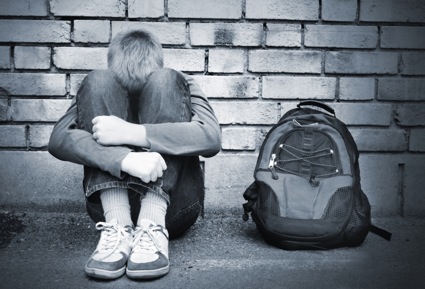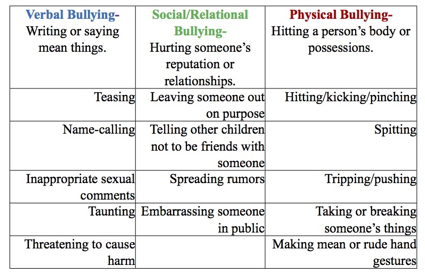What is bullying? Recognizing signs and symptoms in your child
By: Ritu Chandra, M.D.
This blog is part one in a two-part series about bullying. You can read the second part part here, which describes the harmful, long-term effects of bullying as well as actions that parents can take to help their child understand, prevent or stop this behavior from occurring.
In the past year, I saw more than a dozen real-life cases of bullying in my own practice, which were certainly not obvious to parents or even medical professionals at first glance. Reported symptoms ranged from intractable headaches, poor school performance, chest pain, throat pain, and hives. In each of these instances, families wanted referrals to specialists for everything from a cardiology workup, ADHD treatment, ENT evaluation, and allergy testing.
One particular 10-year-old came in as a new patient and reported having pain in her abdomen for almost a year. The previous pediatrician had done a long battery of tests, including x-rays, ultrasound and blood tests and had been treating the child with medicines, but the child was continuing to have abdominal pain. Hence, the parents were frustrated and seeking a new pediatrician.
I got a detailed history from the parents, and then I talked to the child alone. She said she looked forward to the weekends and reported that she did not feel pain on non-school days. I then asked direct questions about her classmates and friends, and it became apparent that she was being bullied at school. When I told the parents about the etiology of the abdominal pain, they were shocked! We were able to report the bullying to the school, and it was handled; within a few weeks, this child’s abdominal pain vanished and she is not on medication any more.
Cases such as these demonstrate how prevalent, how severe and devastating bullying can be for today’s children. In some cases the child realized that he/she was being bullied but was too embarrassed to talk about it; in other cases, the child had no framework or words for it and did not realize that he/she was experiencing bullying.
So, what is Bullying?
Bullying is unwanted, aggressive behavior among school-aged children that involves a real or perceived power imbalance. The behavior is repeated, or has the potential to be repeated, over time. Both kids who are bullied and kids who bully others may have serious, lasting problems.
Bullying may be caused by unintentional mean acts or the acts may be clear-cut, intentional cruelty.
3 Types:
Where and When Bullying Happens
Bullying can occur during or after school hours. Most often, bullying occurs in locations where there is least adult supervision e.g. the playground, cafeteria, library, bathrooms. It can also happen while travelling to or from school, in the youth’s neighborhood, or online.
The Roles Kids Play
There are many roles that kids can play. Kids can bully others, they can be bullied, or they may witness bullying. When kids are involved in bullying, they often play more than one role. Sometimes kids may both be bullied and bully others or they may witness other kids being bullied. It is important to understand the multiple roles kids play in order to effectively prevent and respond to bullying.
Cyber bullying
Cyber bullying takes place using electronic technology. Electronic technology includes devices and equipment such as cell phones, computers, and tablets as well as communication tools including social media sites, text messages, chat, and websites.
Examples of cyberbullying include mean text messages or emails, rumors sent by email or posted on social networking sites, and embarrassing pictures, videos, websites, or fake profiles.
Why Cyberbullying is Different
Kids who are being cyberbullied are often bullied in person as well. Additionally, kids who are cyberbullied have a harder time getting away from the behavior.
- Cyberbullying can happen 24 hours a day, 7 days a week, and reach a kid even when he or she is alone. It can happen any time of the day or night.
- Cyberbullying messages and images can be posted anonymously and distributed quickly to a very wide audience. It can be difficult and sometimes impossible to trace the source.
- Deleting inappropriate or harassing messages, texts, and pictures is extremely difficult after they have been posted or sent.
Warning Signs
There are many warning signs that may indicate that someone is affected by bullying—either being bullied or bullying others. Recognizing the warning signs is an important first step in taking action against bullying. Not all children who are bullied or are bullying others ask for help. These warning signs can also point to other issues or problems, such as depression or substance abuse. Talking to the child can help identify the root of the problem.
Signs a Child is Being Bullied
Look for changes in the child. However, be aware that not all children who are bullied exhibit warning signs.
Some signs that may point to a bullying problem are:
- Unexplainable injuries
- Lost or destroyed clothing, books, electronics, or jewelry
- Frequent headaches or stomach aches, feeling sick or faking illness
- Changes in eating habits, like suddenly skipping meals or binge eating. Kids may come home from school hungry because they did not eat lunch.
- Difficulty sleeping or frequent nightmares
- Declining grades, loss of interest in schoolwork, or not wanting to go to school
- Sudden loss of friends or avoidance of social situations
- Feelings of helplessness or decreased self esteem
- Self-destructive behaviors such as running away from home, harming themselves, or talking about suicide
Signs a Child is Bullying Others
Kids may be bullying others if they:
- Get into physical or verbal fights
- Have friends who bully others
- Are increasingly aggressive
- Get sent to the principal’s office or to detention frequently
- Have unexplained extra money or new belongings
- Blame others for their problems
- Don’t accept responsibility for their actions
- Are competitive and worry about their reputation or popularity
Why don’t kids ask for help?
Statistics show that bullying was reported to an adult in only about a third of cases. Kids don’t tell adults for many reasons:
- Bullying can make a child feel helpless. Kids may want to handle it on their own to feel in control again. They may fear being seen as weak or a tattletale.
- Kids may fear backlash from the kid who bullied them.
- Bullying can be a humiliating experience. Kids may not want adults to know what is being said about them, whether true or false. They may also fear that adults will judge them or punish them for being weak.
- Kids who are bullied may already feel socially isolated. They may feel like no one cares or could understand.
- Kids may fear being rejected by their peers. Friends can help protect kids from bullying, and kids can fear losing this support.
When adults remain unaware of bullying, they are not able to offer support, encouragement and help to stop the bullying behavior. Therefore, it is important that parents remain watchful of the aforementioned warning signs to cut bullying off at an early stage.
Parental awareness about bullying and helping children to understand what bullying is and how to develop a course of action for preventing or stopping the behavior is crucial. The effects of bullying can be devastating for children of all ages. Next week, we will examine some of the effects of long-term bullying for the victims and the bullies as well as some ways that parents can help their children with this issue.
Dr. Ritu Chandra is the founder of Preferred Medical Group, with locations at Phenix City Children’s and Fort Mitchell Clinic. She is a board-certified pediatrician and specializes in ADHD, asthma, and school-related problems.
Photo Credit: istockphoto.com




